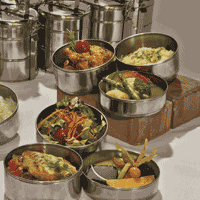Home-meal replacement is the fastest-growing meal segment and it’s cutting a swath through restaurant service.
Meals on the go are nothing new in the foodservice industry. Over the past half-century, entire market segments have been created to cater to road warriors and pressed parents. But, at the same time, in recent years there’s been a marked shift in consumer behaviour when it comes to sourcing those grab-and-go meals, and, increasingly, they’re now taking those meals home with them.What’s more, a growing number of families are looking for healthy, ‘home-cooked’ meals (by someone else) and finding them outside of the traditional boîte. So what does the “new take-out” look like? To begin, the lingo has changed from take-out, to home-meal replacement (HMR) or meal solutions. Regardless of the jargon though, what it means, is that a burger and fries might suffice for the occasional outing or quick dinner fix, but today’s Canadian diner has an increased appetite for home-style, three-course meals made with all-natural, healthy ingredients.
Food that is healthy and flavourful is making the grade, which explains why ethnic meals with Indian orMediterranean influences are among the top homemeal
replacement preferences. And, comfort foods, at either a basic or gourmet level, are quickly becoming a staple in the HMR trade. Busy professionals, parents
and caregivers are happy to pick up top-grade lasagna, pot roast, mashed potatoes, mac and cheese and other throwbacks to an era when people had the
time and inclination to cook at home.
According to Svetlana Uduslivaia, a senior research analyst with the Chicagobased research firm, Euromonitor, convenience is a major driver behind the interest in prepared meals. “The demand is further supported by wide product availability and assortment for almost every taste and need: ethnic varieties (now beyond traditional North American varieties, Italian meals and sushi); healthier options (including reduced calorie, vegetarian, vegan meals, glutenfree, et cetera); and meals for those who just want their favourites such as meat and potatoes or burgers, organic products, thin-crust pizza, et cetera.”
The demand for take-out options is drawing new players,moving into a space typically dominated by family restaurants, QSRs and pizza delivery. Grocers, for
example, are expanding their deli sections, beyond the classic rôtisserie chicken and ribs, to a more eclectic menu. Home-delivery services are also springing up,
with the sole purpose of providing ample portions of slow-cooked favourites.And, not to be left on the sidelines, gourmet restaurants and caterers are finding a “fast-food” market for signature dishes that deserve a place to call home.
As Jean-Francis Quaglia, chef and proprietor of Provence Marinaside, a high-end French resto in Vancouver, which also operates Allô: Provence to
Go, puts it, “Sometimes our customers really want to have a gourmet home meal. We have always believed in making that more accessible for them.”
So, whether it’s a grocery counter or high-end restaurant, home-meal replacement has become an important component for many types of foodservice
operations. The biggest challenge is finding the right balance between taste, quality and price for the target audience of yuppies, seniors and busy working parents.
The Toronto-based NPD Group research firm has reported a number of key trends in supermarkets as they pertain to the HMR piece of the foodservice
pie. Its recent study shows that fully prepared food from grocers is the fastest-growing foodservice segment, and the demand for inhome dinners rose significantly in 2010, after many years of “flat-lining.”
A growing interest in taste, variety and healthy options—not to mention convenience—is driving the trend, says Linda Strachan, foodservice industry analyst with the NPD Group in Toronto. “The fact you can pick up a meal while you get milk is a big plus. It’s not just about supper. Lunch is growing quite quickly as well.”
Of course, there’s more to HMR than the regular run-of-themill standbys. “If [grocers] want to get serious they need to step up and offer something more interesting than rôtisserie chicken and potato wedges. Some are falling short on items like salads and side dishes. However, Sobey’s, for example, is doing a pretty good job in terms of variety in sides and interesting ethnic main dish items, such as sushi, grain-based salads, grilled panini sandwiches and Asian-style chicken wings,” says Strachan.
Not surprisingly, the strongest market for home-meal replace-ment is in urban hubs where there is a wealth of people with little time and more money to spend. “It’s more of an urban thing because of the commuting and convenience,” Strachan reports.
Edmonton-based, grocery chain, Planet Organic has been in the home-meal replacement game for a number of years. While many of its organic, vegetarian and vegan dishes are prepared on-site, other pecialty items, such as gluten-free meals are outsourced, says Heather Prins, corporate deli and commissary manager at the company’s Edmonton location. “Prepared meals continue to be a growing segment for us — probably in the range of 10 to 11 per cent a year [for the past three years]. In our case, it’s because we can cater to different dietary requirements. This is one area where pricing is not an issue, since people are willing to pay for antibiotic- and hormone- free meats and organic ingredients.”
Comfort foods seem to be the predominant choice (turkey meatballs, chicken pot pie, pizza as well as mac and cheese, rank among the bestsellers). However, depending on the store location and traffic patterns, preferences can vary, Prins says. “All stores have a busy lunch crowd, but some are closer to offices, others to condos.”
Specialty restaurateurs are also getting into the takeout game as away to expand business. The signature barbecue dishes at The Stockyards in Toronto have become so popular, owner, Tom Davis, is able to use homemeal replacement to reach a bigger market. “The neighbourhood has changed in the last few years and has become a niche for a lot of young and busy families who love great takehome meals,” he says. “We get a lot of couples with younger children as well as seniors.”
But this kind of response is new, as it was only recently that restaurant management introduced take-homemeals to boost sales on slower nights. Based on different feature themes, the meals include enough meat (whole chicken, ribs, brisket) and side dishes (fries, seasonal sautéed greens, potato salad) to feed four to six people for between $18 and $26.
Davis reports sales have increased 15 to 20 per cent whenever take-home meals are offered.“It justmakes it easier for customers, because they don’t have to go through the process of deciding what to [make] for dinner. People’s lives are very busy, which is why there’s a need and a niche for this.Qualitywill always sell, because people are much more knowledgeable about food.”
The push for HMR options has been leveraged by astute caterers, too. Since 2006, Charlene Nero, owner of the Minesing, Ont.-based catering company Bite Me! has been making two monthly home deliveries of meals sourced from local ingredients to diners in the Greater Toronto Area.
Nero saw the need for home-replacement meals well before it became a trend. “I started this business after seeing people load up on grab-and-go items that were full of additives and ingredients that you wouldn’t even recognize. I wanted to deliver well-cooked, locally sourced food for people who wanted the convenience
but were also worried about good taste and health.”
Her instincts were spot on. Since then the local-food movement gained traction. And, while she has always had hermainstay clients in urban professionals (the 20 or 30-something crowd)many are now requesting delivery of healthy meals for their elderly parents. “These seniors have more sophisticated palates and are interested in good food but simply can’t make it anymore. We are also seeing more single people who don’t want to cook for themselves.”
A wide range of starters in two to six portion sizes make up the menu, which usually costs approximately $80. For the most part, it’s comfort food that wins the day. “We concentrate on things that don’t have the most expensive ingredients but take time to make. Anybody can buy a piece of Angus filet and put it on a grill, but a person won’t have eight hours to braise a cut of beef,” says Nero.
The biggest-selling items on the Bite Me! menu include meatloaf with mashed, roasted sweet potatoes and pot roast—“we sell twice as much as anything else when it’s on the menu,” laughs Nero — and Mediterraneaninspired dishes such as chicken espagnol, chicken cacciatore and lake perch Florentine.
On a larger scale, the Great Events Group in Calgary has been expanding its home-meal replacement offerings for delivery to the office crowd as well as pickup items for commuters.
In early 2010, the company launched its Tiffin for You division, which delivers threecourse meals to corporate customers in downtown office buildings. These are delivered in unique stainless steel containers sourced fromIndia,whose layers can be taken apart for serving an entrée, side and dessert.
“The concept came from Mumbai,” explains Jessica Penalver,marketingmanager for Tiffin For You. “So we went with a bit more of an Indian theme for the menu.”
While bestsellers include lamb curry and butter chicken at $15, there is also big demand for staples such as lasagna, mac and cheese and vegetarianmeals at $13 per order.
Great Events also runs the Cravings Market Restaurant. The five-year old business, offers take-home meals to feed two to three people. “People drop by to grab a meal for lunch or to take something home with them for dinner,” Penalver says. “We’re actually seeing more businesses dedicated exclusively to home-meal replacement. People like the convenience [and] either don’t have the time or the capabilities to cook their own. Also, people are simply not settling for fast food. They really want better quality.”
At the end of the day, the circumstances that have thrust HMR into the limelight seem to be a perfect storm of the growing urban foodie culture, a commitment to
healthy sustainable cuisine and the exponentially accelerated pace of modern life. With a slew of hungry, but food-literate, yuppies looking for healthy, delicious and
convenient meals, it’s hard to see this particular trend waning anytime soon.




















